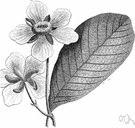NSF-08 isolated from
Dillenia Indica Linn in north east India.
O elevado numero de especies identificadas na arborizacao pode ser explicado pelo comportamento corriqueiro dos municipes em introduzir de maneira voluntaria exemplares no meio urbano e pelo proprio governo municipal que, por nao possuir um plano de arborizacao efetivo, acaba promovendo a introducao de especies diferenciadas com o passar do tempo, como e o caso recente de Handroanthus chrysotrichus,
Dillenia indica e Tabebuia roseoalba.
Antidiabetic, hypolipidemic and histopathological analysis of
Dillenia indica (L.) leaves extract on alloxan induced diabetic rats.
This ecosystem is dominated by Dipterocarpus aff., tuberculatus Roxb., and
Dillenia obovata (Blume) Hoogland, which is characterized by rough bark and is favorable for epiphyte inhabitation.
Based on in situ observation, the common pioneer trees species found during site surveys were such genera as Aleurites (Euphorbiaceae), Amomum (Zingiberaceae), Cratoxylum (Clusiaceae),
Dillenia (Dilleniaceae), Elaeocarpus (Elaeocarpaceae), Ficus (Moraceae), Hopea (Dipterocarpaceae), Ilex (Aquifoliaceae), Lithocarpus (Fagaceae), Norrisia (Loganiaceae), Pentace (Tiliaceae), Pentaspadon (Anacardiaceae), Sarcotheca (Oxalidaceae), and Vitex (Verbenaceae).
In Brazil, seven genera have been recorded: Curatella Loefl., Davilla Vand.,
Dillenia L., Doliocarpus Rol.
These include a predatory katydid from the subfamily Meconematinae feeding on flowers of
Dillenia suffruticosa (Griff, ex Hook.f.
In Hainan, the tropical forest is characterized by Vatica and Hopea (Dipterocarpaceae), Heritiera (Sterculiaceae), Amesiodendron (Sapindaceae), Homalium (Salicaceae), Alphonsea (Annonaceae), Gironniera (Ulmaceae),
Dillenia (Dilleniaceae) and Ancistrocladus (Ancistrocladaceae).
For example, [6] reported that germination of seeds in
Dillenia indica (Dilleniaceae) was enhanced when mucilage was washed off from the seeds, thus allowing them to imbibe water and germinate.
The exogenous use of auxins on stem cuttings for vegetative propagation has been successfully developed in much conservation prioritized (rare, endangered, and threatened) and commercially valuable plants such as Pongamia pinnata [22], Ginkgo biloba [23], Hildegardia populifolia [24], Panax pseudoginseng [25], and
Dillenia suffruticosa [26].
 dillenia - any of several evergreen trees or shrubs of the genus Dillenia grown for their foliage and nodding flowers resembling magnolias which are followed by fruit that is used in curries and jellies and preserves
dillenia - any of several evergreen trees or shrubs of the genus Dillenia grown for their foliage and nodding flowers resembling magnolias which are followed by fruit that is used in curries and jellies and preserves